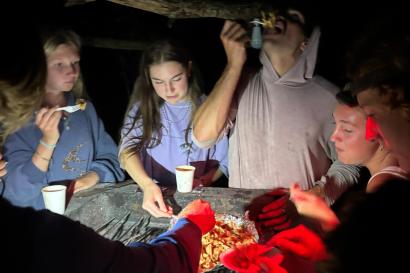While preparing for my semester in Quito, it completely escaped my mind to research the food and eating habits of Ecuador. Based on the meals I had been served in local Mexican and Columbian restaurants at home, I had the misconception that most meals would consist of rice, beans, a protein and vegetables by the side…however, I was totally wrong. Ecuadorians have their very unique food/eating culture and even dining table manners that need to be followed in the home, which was surprising to me. When I decided I was going to study abroad, I was honestly worried about what I would be eating and if I would enjoy the local food. The first week was a test of my ability to adapt to the sudden change in diet. I was offered so many local dishes and pastries to try, but my taste buds did not agree with the descriptions my host parents told me.
As part of my immersion experience into the Ecuadorian culture, I was reminded that the food I will be eating is a reflection of the culture, history and geography of the people and country. Although I can confidently say that I am not a “foodie” as quite a few Americans pride themselves to be; I had to push myself out of my comfort zone (otra vez) and politely eat what I was served. Yes! I am not adventurous with my food. It has to be prepared a certain way, be at a specific spice level and most importantly be steaming hot when served.
So yes! My first week in Ecuadorian food was interesting, and I am going to share all the new things I ate, and phrases used when talking about foods or mealtime so that you have an idea of the Quiteño specific palette/food culture.
Meals
-Arepas: I had never heard of this pastel before even though it’s not really a pastry but a fried corn mix tortilla with stuffing (relleno de carne o queso)
-Ecuadorian pizza: similar to a flatbread without tomato sauce served with meats or vegetables (vegetarian and vegan options available)
-Humita: very similar to an empanada but made from a sweet corn and stuffed with a salty cheese. This is eaten during la cena.
Snacks
-Barra de chocolate de maní (peanut chocolate bars)
-Tortillas de arroz, plátano, quínoa, yuca, arroz
-Aplanchado (baked puff pastry covered with a sweet glace)
-Melvas: cookies filled with creme and covered in chocolate
-Biscocho: very famous biscuits in Ecuador - looks similar to shortbread cookies
Fruits
-Uvillas: slightly bigger than a grape
Soups
-Sopa de quínoa
-Timbushca: this soup has a Quechua name and is a soup with vegetables, potato, and meat chunks
Phrases
-Desayuno: breakfast which is very light. Usually a cup of coffee or fresh fruit juice, fruit, and bread
-Almuerzo: the largest meal of the day, consisting of a 3-course meal starting with a soup (la sopa), main dish (el segundo), a cup of fresh juice and postre (dessert). At school, some students may bring their own lunch, return home for lunch, or eat at local tiendas de almuerzo.
-La Cena/La Marienda: also very light meal with a cup of coffee and a local “pastry”
-Estoy lleno/satisfecho: I am full/satisfied
Although I now have a few favorite Ecuadorian dishes, I could not have imagined this when I had arrived. Not to disregard the abundant consumption of rice, potatoes, beans/lentils and a variety of fruits and vegetables that accompany most meals, I had conversations with my host parents about what I like to eat and my interest in eating more native meals. However, what is served by your host family is dependent on what they usually eat and your dietary restrictions. My first week was full of many adjustments and learning about my new home - which will continue throughout the semester. I have enjoyed eating new local foods and pushing myself to try new foods that I may not be accustomed too.
P.S.- A secret tip is to try and help out in the kitchen if you can so that you see how meals are prepared and it opens the door to have conversations about food and the cultural differences.

Tabitha Ato
I would describe myself as a fun but reserved person. I am curious and love learning and sharing about my experiences. I enjoy planning and organizing events but great music always gets me on my feet.








